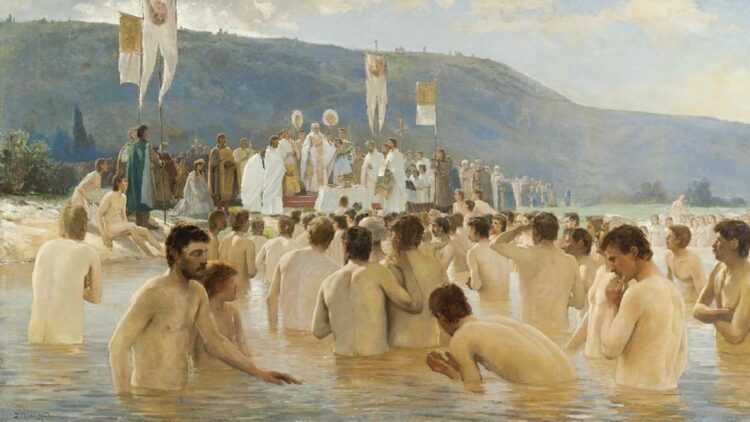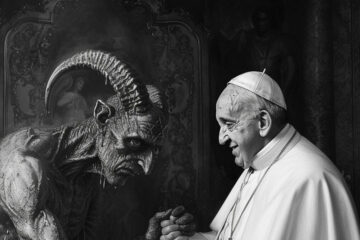The Secret Gospel
On the 115th anniversary of his birth, we bring you a previously unpublished piece, from 1973, written by the great wit, writer, and scholar, Revilo Pendleton Oliver, born in Texas on 7 July, 1908.
by Revilo P. Oliver
IF WE HAD all the early versions, oral and written, of the Judaeo-Christian Gospels that were eventually included in the “New Testament,” we would certainly be able to trace the process of constant revision the texts had undergone before they were canonized by the “Fathers of the Church.” After canonization, copies were distributed widely, so that only relatively minor revisions were possible thereafter. Even with the limited texts that have survived, we still see numerous inconsistencies in the gospel stories. One very clear example is the drastic censoring of a passage in the Gospel that is attributed to a certain unidentified Marcus (“Mark”), of which one of the earlier texts was preserved in a letter by Clement of Alexandria that was discovered by Professor Morton Smith. (See the text with Professor Smith’s commentary in his Clement of Alexandria and a Secret Gospel of Mark, Harvard University Press, 1973; with an English translation in his more popular book, The Secret Gospel, New York, Harper & Row, c. 1973.)
I read Professor Smith’s Secret Gospel shortly after it was published, and I read most of the Harvard volume when it reached the University of Illinois library. It has garnered attention largely on the basis of the Christian rituals described in it, which could be interpreted as homosexually erotic. Smith mentions in passing that the wording leaves open the possibility that Jesus and the disciples could have “united physically” during a secret ritual which revealed to them “the mystery of the Kingdom of God,” according to the Gospel.
I think it highly probable that the manuscript that Smith discovered is a copy of part of an authentic letter by Clement. The evidence that Smith lucidly sets forth in his smaller book is cogent, and the stylistic tests reported in detail in the longer one are probative.
When Smith speaks of a “Gospel of Mark,” he is merely using the conventional designation of the writing, just as people refer to the “Letters of Paul,” although everyone knows that the letters collected in the New Testament were manufactured by a committee long after the death of the person in whose name they were composed. It is possible that there were Orientals who had in some way acquired Roman citizenship and had a right to use the praenomen Marcus and the cognomen or nickname Paulus, although it is certainly odd that their family names are never stated — but the individuals, whether real or imagined, are important only as they appear as characters in the various stories told about them.
As everyone knows, the New Testament is a kind of anthology compiled around the middle of the fourth century by persons who selected from the enormous number of “Gospels” that had been composed by that time the stories that particularly appealed to their tastes and purposes. Hundreds of “Gospels” that they rejected (because the stories told in them too obviously conflicted with the stories they preferred) are now extant, in whole or in part, and almost every considerable find of papyri from the second to the sixth centuries brings to light fragments of “Gospels” previously unknown. Some of these “Gospels,” such as that of Jacob in Vol. V of the Bodmer Papyri, are so well imagined that one cannot guess why they weren’t included in the collection that was eventually recognized as the official New Testement.
It is not at all astonishing, therefore, that there was a fuller and earlier version of “Mark” containing either an esoteric doctrine revealed only to initiates or a doctrine which it was thought expedient to censor drastically before the story was included in a more or less official collection which would almost inevitably be seen by persons who were not members of the cult.
It seems to me quite likely that the censorship was carried out in two stages, and that the original tale that bore the name of Mark was the version that Clement in the letter says was part of the “New Testament” of the Carpocratians. The circulation of this “Gospel” would have sufficed to establish the tradition that there had been an “apostle” named Marcus, who had been an eyewitness of the events narrated. Then, when some groups of Christians felt that that doctrine outraged their own moral sense (it explicitly stated what Clement’s later “more spiritual” version only implied, using the phrase “naked man with naked man”) or that such open repudiation of the moral standards of civilized society made proselytizing more difficult, the text was censored, probably in the time of Clement, to produce a much milder version, but retaining the story about secret initiations performed by the supposed Son of God and similar details, and it was claimed that this censored version was the “authentic” one. This is the version from which Clement quotes in the letter as “authentic” to discredit the Carpocratian version as interpolated. Whether Clement believed what he said or knew better cannot be determined; lying for the Lord has always been a normal and habitual act of piety.
It must be remembered that the Carpocratian version was dangerous, since Roman law was enforced in the provinces, and possession of the Carpocratian version would go far to convict the possessor of the crimes and immorality recommended in it. At the third stage in the process, even the censored version was thought too drastic for circulation to the general public, and was reserved for initiates who had been initiated into the “Kingdom of Heaven” in the way that was cautiously described in it. One can see that many prospects would have been repelled by the rather obvious implications of it.
The censored version, accordingly, was hurriedly censored a second time to facilitate proselytizing Gentiles, thus producing a text that must have been substantially similar to the “Mark” that was included in the New Testament.
The foregoing is an hypothesis that fits the facts, so far as they are known. It must be remembered that we know absolutely nothing about what beliefs were prevalent among the various groups of Christians before 112, when the younger Pliny, as recorded in his famous letter to Trajan, investigated a band of them in Bithynia, and they convinced him that they were not guilty of ritual murders or other crimes for which it would be his duty to punish them. Of course, there was no “New Testament” at so early a date, but some stories about Jesus could have been in circulation in written form, and it is perhaps significant that the Christians whom Pliny investigated either had no written documents or were able to conceal the existence of such documents from him.
We do know that the Carpocratians and, no doubt, other early Christian sects, predominantly Jewish in membership although they probably included some other Orientals and perhaps a few low-grade persons of European race, did practice ritual murders, often eating selected cuts from the bodies of the victims or drinking their blood, and that they frequently did not escape detection of their holy suppers, with the result that they were persecuted by the wicked and unregenerate pagans. There probably were some innocuous groups also, but we have no means of knowing that the profligate and criminal sects that attracted attention were not, in fact, the majority even in the time of Clement, who may represent what was at that time a minor sect that had revised the doctrine and composed scriptures to make it seem respectable or, at least, innocuous.
Incidentally, some scholars have recently noticed among the recent discoveries a previously unknown romance, the Phoenicica, by a previously unknown writer, Lollianus. The fragments were edited by Heinrichs in a volume of the Bonn Papyrological series late in 1972. The story includes a scene of ritual murder by a gang of either Christians or Jews — unfortunately the text is mutilated, so it is impossible to tell which sect is having the fun.
To return to our immediate subject, the fuller version of “Mark” quoted in Clement’s letter so perfectly fills in the obvious gaps in the story told in the New Testament that, as Smith has shown, it must be regarded as an earlier version of the tale, which was hurriedly and rather ineptly expurgated to produce the one that was put into general circulation and was incorporated in the New Testament when that collection was put together.
I conclude, therefore, that Smith’s discovery has added an interesting detail to the little that we know about the way in which Christianity was formed.
By the way, this Clement, who was an historical figure and probably had much to do with cleaning up Christianity to make it more acceptable to non-Jews, should not be confused with the purported author of the Recognitiones, which are attributed to a mythical Clement, who was invented when the list of early popes, in which he is third, was fabricated. The Recognitiones, which are probably one of the earliest Christian scriptures, are, of course, older than the list of popes, and it is likely that the.very idea of an “apostolic succession” of popes was taken from the romance, in which the hero (who tells the story in the first person, just as, for example, does the Lucius who is the hero of Apuleius’s Metamorphoses) is called Clement. He claims to have been a pal and travelling companion of Peter, the “apostle” who figures largely in the New Testament stories, and the romance purports to be a letter written to a brother of Jesus. The Recognitiones were probably omitted from the New Testament for the same reason that the supposed letters of Jacob, brother of Jesus, were omitted, together with the Shepherd of Hermes, the Acts of Peter, the Twelve Apostles, etc. etc.: They gave a version of the “Son of God” that had not been as fully elaborated as it is in the stories that were included. It is significant that there exists a later version of the Recognitiones, the so-called Homiliae, which has been drastically censored to eliminate some of the more absurd miracles reported in the earlier version. Smith’s book will make the holy men yowl, since they will fear, perhaps unnecessarily, that it will be bad for business. I have seen only one review, a long diatribe in the Jesuit propaganda sheet called America; its author lies about what Smith says in the book, and I am a little astonished, not that the holy man lies, for that is only natural, but that he is so impudent as to take the risk that some who read his review may also read the book. The interesting thing about the review is that what really sends the dervish into a tizzy is the fact that Smith, in addition to the Harvard volume, which will necessarily be read only by a very few members of the small minority that still reads Greek, published The Secret Gospel, a book which is likely to have a considerable number of readers who do not know Greek, i.e., many potential customers of holy men.
Many men, partisans of our European race, say that the origins and early forms of Christianity are not very important or even very interesting, and that what matters is what Christianity became when it was taken over by our people, and what it meant during all the centuries in which it was, whether we like it or not, a fundamental part of our civilization and formed much of a tradition that we cannot escape any more than we could escape our ancestry. Whether what I write today on the subject will, as I hope, do something to mitigate the critical paralysis of the American mind today, I do not know. The issue is vital and inescapable: Otherwise I would not have written as I have.
It is good to remember Fritsch, who wrote “Es steht keine Frage so im Mittelpunkt der Aussprache wie die religiose” (“There is no question that is as central to the discussion as the religious one”) — if I am not mistaken that comes from the defence that he published after he was imprisoned in Germany, shortly before the First World War, for having “defamed” the Jews by quoting their holy books.
The “Secret Gospel” discovered by Professor Smith is interesting only because it preserves part of the “Gospel of Mark” in the form that it had before it was censored to produce the version that was included in the “New Testament.” There is nothing novel about the doctrines it includes; they are all found in many other “Gospels” and in some they are more clearly or drastically stated. Secret nocturnal initiations, a morbid aversion to women, and implications of male homosexuality are commonplaces among the early Christian writings that have survived.
For a quick comparison, see a “Gospel of Thomas” that is edited (from a damaged and incomplete copy of the Greek text, found around 1900, and a complete Coptic translation discovered around 1948) and translated by Jean Doresse, L’Evangile selon Thomas, ou les Paroles de Jesus, Paris, 1959. This particular “Gospel of Thomas” (there are several writings so entitled) is simply a collection of the “sayings of Jesus,” and includes most of those on which Christians dote because they read into them meanings congenial to their own sentiments. Some of these appear in that collection in a fuller and more explicit form that it would be hard for even the pious to misunderstand.
For example, in “Matthew” (which is a heavily censored and interpolated version of a “Gospel according to the Hebrews” that almost got into the “New Testament” when that anthology of tales was put together in approximately its present form in the fifth century, and was suppressed only at the last minute — Jerome had already made a Latin version for inclusion in the Vulgate), Jesus is made to say that people must love him more than they love their parents; in this “Thomas” he is more explicit: Children must hate and despise their parents as much as he hates and despises his own father and mother.
This is, of course, part of his demand for an inversion of recognized morality and for the destruction of organized society. These doctrines were naturally suppressed by the early Christians in the third and fourth Centuries, when they tried to appear respectable. He also calls for nudism (presumably in the secret conclaves of his followers) and exhibits the morbid aversion to women and the emphasis on male homosexuality that was a part of the doctrine of many early Christian sects. He even says that females are “not worthy of life” and excludes them from the “Kingdom of Heaven” (which is to be attained in some unstated way here on Earth, for there is no statement that either sex will survive after death), although he claims that he has the magic power to “save” a few particularly deserving women by converting them into males.
The sayings of Jesus in this “Thomas” are in harmony with the somewhat milder implications of the fuller version of “Mark” quoted by Clement — a version which, I think, had already been censored and toned down. In both it is likely that the “Kingdom of Heaven” was attained in homosexual orgies by males under the influence of amanita muscaria, the hallucinatory drug that was commonly used to excite religiosity, but that is not stated explicitly in any Christian text that I have seen, since the administration of the drug in the food or drink of a communal supper was probably a professional secret of the holy men.
It is also, perhaps, worthy of note in Clement’s letter that while he quotes the fuller version to a fellow holy man, he reminds him that if the simple-minded jerks of his congregation ask about it, he should take an oath that no such secret version exists. That, of course, is just normal behavior among theologians and the like.
* * *
Source: revilo-oliver.com







Dr. Oliver was a remarkable scholar and researcher and a treasure to the Aryan race, especially on the subject of origins of Jewish Christianity. With “The Secret Ritial” there is no wonder that Christianity has such appeal to the queer community It is good to remember Fritsch, who wrote “Es steht keine Frage so im Mittelpunkt der Aussprache wie die religiose” (“There is no question that is as central to the discussion as the religious one”) — if I am not mistaken that comes from the defence that he published after he was imprisoned in Germany, shortly before the First World War, for having “defamed” the Jews by quoting their holy books. Excellent timing, Kevin, putting this up with RPO’s reference to Fritsch. We just added Dr. Dalton’s 2023 translation of… Read more »